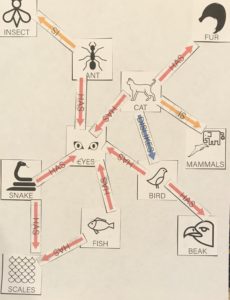Ages 5-14
AI agents have to store and organize information in their memory. One of the ways they do this is by using semantic networks. Semantic networks are a way of representing relationships between objects and ideas. For example, a network might tell a computer the relationship between different animals (a cat IS A mammal, a cat HAS whiskers). Below is an example image of a semantic network.

Key Vocabulary
- Knowledge representation: a structure or symbol that a computer uses to store and organize information about the world [1]
- Semantic network: a knowledge representation that represents relationships between concepts and ideas in the form of a network. It is generally shown as a graph where concepts/ideas are “nodes” and relationships are “edges” or arrows [2]
- Knowledge-based artificial intelligence: a “computer program that reasons and uses a knowledge base to solve complex problems” [3]
- Natural language processing: “is a subfield of linguistics, computer science, information engineering, and artificial intelligence concerned with the interactions between computers and human (natural) languages” [4]
Activity
Cut out the Semantic Network card deck and have students use the cards to build their own semantic network. The square cards represent objects or ideas. The arrow cards represent relationships. Blank arrows and squares can be used to write-in custom relationships and concepts. Use glue and paper to make your own network to teach an AI agent. An example semantic network built using the cards is shown below.
 Students can simulate an AI-user interaction using their semantic networks. Two students can trade completed semantic networks and ask their partner questions about the network they created (e.g. “What is a cat?”). The student’s partner should answer the questions using the semantic network as their only guide (simulating an AI agent whose only knowledge is based on the semantic network).
Students can simulate an AI-user interaction using their semantic networks. Two students can trade completed semantic networks and ask their partner questions about the network they created (e.g. “What is a cat?”). The student’s partner should answer the questions using the semantic network as their only guide (simulating an AI agent whose only knowledge is based on the semantic network).
Reflection Questions
- What types of relationships were you able to express using the semantic network? What was harder to capture?
- Did any of the connections you made surprise you?
- What happens if you put false information in the semantic network? If you were building an AI agent, how could you correct for programmer “errors”?
- What does it mean for the computer to understand what a “cat” is (for example)–if the computer doesn’t know any information outside of what you built into the semantic network?
- Do you think the way a computer understands concepts using a semantic network is similar or different to how we as humans understand concepts?
- What would you do if the system needed to learn new knowledge (i.e. add to its semantic network over time)?
- Compare the semantic network to other ways that computers learn and represent knowledge—for example, a neural network. How are they similar/different? What types of tasks would each knowledge representation be better suited for?
Real World Implications
- WordNet is a natural language processing system that uses semantic networks to help computers understand the connections between different words in the English language. It’s like a dictionary for the computer with many links connecting words to each other so that the computer can understand common-sense relationships.
- ConceptNet is similar to WordNet, but connects compound concepts in a semantic network so computers can understand common-sense relationships between entities and ideas.
- Semantic networks can be used to aid in detecting plagiarism by enabling the computer to recognize similarities in word meanings between two texts (even if the specific words differ).
AI Literacy Competencies
Representations, Decision-Making, Human Role in AI, AI’s Strengths & Weaknesses, Programmability
AI Literacy Design Considerations
Leverage learners’ interests, critical thinking, opportunities to program, promote transparency, explainability
Links to other subjects
Depending on the cards and connections used (which can be customized using the attached InDesign file), building semantic networks could be used to teach about connections in a variety of different subjects including:
- Biology
- Plants and animals
- Human body
- Foreign language
- Learning vocabulary and verb conjugations
- Learning about the self
- Family relationships
- Likes/Dislikes
Links to Exhibits and At-Home Activities
- This activity is related to the Semantic Network exhibit concept and at-home activity